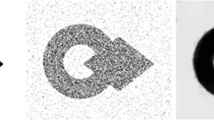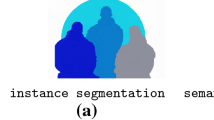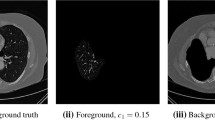Abstract
Morel and Solimini have established proofs of important properties of segmentations which can be seen as locally optimal for the simplest Mumford-Shah model in the continuous domain. A weakness of the latter is that it is not suitable for handling noisy images. We propose a Bayesian model to overcome these problems. We demonstrate that this Bayesian model indeed generalizes the original Mumford-Shah model, and we prove it has the same desirable properties as shown by Morel and Solimini.
Similar content being viewed by others
References
L. Ambrosio, N. Fusco, and D. Pallara, Functions of Bounded Variation and Free Discontinuity Problems. Oxford University Press, 2000.
L. Ambrosio and V. Tortorelli, “Approximation of functionals depending on jumps by elliptic functionals via gamma convergence,” Commun. Pure Appl. Math., Vol. 43, pp. 999–1036, 1990.
L. Ambrosio and V. Tortorelli, “On the approximation of free discontinuity problems,” Boll. Un. Mat. Ital, Vol. 6-B, pp. 105– 123, 1992.
G. Aubert and P. Kornprobst, Mathematical Problems in Image Processing: Partial Differential Equations and the Calculus of Variations, Springer-Verlag, 2002.
A. Blake and A. Zisserman, Visual Reconstruction, MIT Press: Cambridge MA, 1987.
G. Box and G. Tiao, Bayesian Inference in Statistical Analysis, Addison-Wesley Pub. Co., Reading, Mass., 1973.
A. Chambolle, “Image segmentation by variational methods: Mumford-Shah functional and the discrete approximations” SIAM Appl. Math., Vol. 55 No. 3, pp. 827–863, 1995.
Antonin Chambolle and G. Dal Maso, “Discrete approximation of the mumford-shah functional in dimension two,” M2AN, Vol. 33, No. 4, pp. 651–672, 1999.
D. Crisp and G. Newsam, “A fast efficient segmentation algorithm based on region merging,” In Proceedings of the IVCNZ, 2000, pp. 180–185.
E. de Georgi, Gamma-convergenza e g-convergenza, Boll. Un. Mat. Ital, Vol. 5, No. 14-A, pp. 213–220, 1977.
L. Evans and R. Gariepy, Measure Theory and Fine Properties of Functions, CRC Press, 1992.
D. Geman and S. Geman, “Stochastic relaxation, Gibbs distributions and the Bayesian restoration of images” IEEE Trans. PAMI, Vol. 6, No. 6, pp. 721–741, 1984.
T. Kanungo, B. Dom, W. Niblack, D.Steele, and J.Cheinvald, “MDL based multi-band image segmentation using a fast region merging scheme,” Technical report, IBM Research Report RJ-9960 (87919), 1995.
G. Koepfler, J.M. Morel, and S. Solimini, “Segmentation by minimizing a functional and the merging methods, SIAM J. on Numer. Anal., Vol. 31, No. 1, 1994.
Y.G. Leclerc, “Constructing simple stable descriptions for image partitioning,” International Journal of Computer Vision, Vol. 3, pp. 73–102, 1989.
T. Lee, “A minimum description length based image segmentation procedure and its comparison with a cross-validation based segmentation procedure,” Journal of American Stat. Assoc., Vol. 95, No. 449, pp. 259–270, 2000.
G. Dal Maso, An Introduction to Gamma Convergence, Birkhäauser, Boston, 1993.
J.M. Morel and S. Solimini, Variational Methods in Image Segmentation, chapter 5, Birkhäser, 1995.
D. Mumford and J. Shah, “Optimal approximations by piecewise smooth functions and associated variational problems,” Commun. Pure Appl. Math., Vol. 42, pp. 577–685, 1989.
T Richardson and S Mitter, “Approximation, computation and distortion in the variational formulation,” Geometry-Driven Diffusion in Computer Vision, 1994.
J. Rissanen, “Modeling by shortest data description,” Automatica, Vol. 14, pp. 465–471, 1978.
T. Tao and D. Crisp, “A useful bound for region merging algorithms in a bayesian model,” In ACCV, Adelaide, Australia, 2003, pp. 95–100.
S. Zhu and A. Yuille, “Region competition: unifying snakes, region growing and bayes/mdl for image segmentation,” PAMI, Vol. 18, No. 9, pp. 884–900, 1996.
Author information
Authors and Affiliations
Corresponding author
Additional information
Trevor Tao was Born in 1977 in Adelaide, Australia, found to be autistic when he was two years old. He was the first autistic child in Australia to have started normal school at the same age as his peers. He later became interested in music, chess, and mathematics. He has been described as a musical savant, and has represented Australia in the International Chess Olympiad in 1994, and won a bronze medal in the International Mathematical Olympiad in 1995. In 2000 he completed a double degree in B.Sc (Mathematics & Computer Science) and B.Mus. (Performance & Composition) at the University of Adelaide. After a short vacation job at the Defence Science & Technology Organization in Adelaide, he became interested in Image Analysis, and studied for a Ph.D. in Applied Mathematics. He is expected to complete his thesis this year.
Dr David J. Crisp graduated from the University of Adelaide (Australia) in 1993 with a Ph.D. in Mathematics. He held several different research positions from 1994 to 1998. In 1999 he joined Australia’s Defence Science & Technology Organisation (DSTO) as a research scientist. His current research at DSTO is focused on the automated detection of targets in synthetic aperture radar imagery.
Dr John van der Hoek graduated from University of Adelaide (Australia) in 1975 with a PhD in Pure Mathematics. He is currently a senior lecturer in the Department of Applied Mathematics at University of Adelaide. His research interests are applied functional analysis, partial differential equations and free boundary value problems, stochastic processes, mathematical finance and signal processing.
Rights and permissions
About this article
Cite this article
Tao, T.CY., Crisp, D.J. & van der Hoek, J. Mathematical Analysis of An Extended Mumford-Shah Model for Image Segmentation. J Math Imaging Vis 24, 327–340 (2006). https://doi.org/10.1007/s10851-005-3631-1
Published:
Issue Date:
DOI: https://doi.org/10.1007/s10851-005-3631-1




